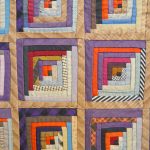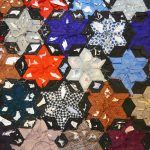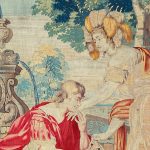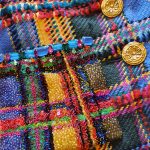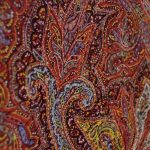This log cabin patchwork is believed to have been used as a ‘carriage rug’. Carriage rugs were made from thick, warm materials and were draped over the knees and legs whilst travelling in a carriage to help protect against chills and draughts. The many overlapping strips of fabric used to make log cabin patchwork create […]
View moreThis unfinished patchwork is made using the English paper piecing technique. Diamond shaped papers have been covered with fabric and arranged into a pattern of colourful stars formed by six diamonds within a framework of darker diamonds. The covered paper shapes are joined together by overcast or whip stitching. The design effectively uses high contrast […]
View moreIn 1982 the Harris received a bequest from a local lady who had recently passed away. Miss Mabel Haythorn (born 1910) lived in an apartment in Frenchwood House in Preston her whole life. We believe she never married and had a private income. In her will, she left the Harris Museum & Art Gallery a […]
View moreIn 1982 the Harris received a bequest from a local lady who had recently passed away. Miss Mabel Haythorn (born 1910) lived in an apartment in Frenchwood House in Preston her whole life. We believe she never married and had a private income. In her will, she left the Harris Museum & Art Gallery a […]
View moreIn 1982 the Harris received a bequest from a local lady who had recently passed away. Miss Mabel Haythorn (born 1910) lived in an apartment in Frenchwood House in Preston her whole life. We believe she never married and had a private income. In her will, she left the Harris Museum & Art Gallery a […]
View moreThe four Tapestries situated in the Drawing Room of Astley Hall date from the mid-17th Century and depict the mythological story of Jason and his quest for the Golden Fleece. They were made in Flanders (Northern part of Belgium) and according to the records of the Victoria and Albert Museum there are only two other […]
View moreThis sample is one of a set of over 90 print samples attributed to the Robert Hindle & Co Print Works in Sabden, Lancashire. The vibrant colours of the samples are a perfect example of the impact that aniline dyes had on the dyeing and printing industries. The first aniline dye was mauveine or ‘Perkin’s […]
View moreThis jacket appeared in the Autumn/Winter 1991-1992 Collection by French designer Christian Lacroix. The design has modernised the traditional tartan pattern, using embellishments like sequins and rhinestones to emphasise the pattern. The key features are the intricately embellished pockets with beads and sequins applied to follow the pattern of the underlying check. This embellishment was […]
View moreThis sample is one of a set of over 90 print samples attributed to the Robert Hindle & Co Print Works in Sabden, Lancashire. The vibrant colours of the samples are a perfect example of the impact that aniline dyes had on the dyeing and printing industries. The first aniline dye was mauveine or ‘Perkin’s […]
View moreThis beautiful textile is an example of an amli shawl, a technique where small woven pieces are hand sewn together and then further embellished with embroidery. Every step of the making process was labour intensive and required high skill levels meaning that amli shawls were highly prized luxury items. Unlike many other styles of shawl […]
View moreFinely woven Kashmir wool shawls from India became status symbols in Europe in the 18th century, and were considered the height of fashion up until the 1870s. As highly desirable commodities, factory-owners in Europe were quick to capitalise on their appeal and employed new industrial machine weaving methods to maximise profits. Towns such as Norwich, […]
View moreUnlike menswear, women’s clothing in the 18th century did not have ‘built in’ pockets and the modern handbag was yet to be invented. Instead, most women wore pockets like these on a tape around the waist, usually over the top of a petticoat but underneath the outer layer of the skirt. Slits could be left […]
View more